Brontë Sisters Worksheets
Do you want to save dozens of hours in time? Get your evenings and weekends back? Be able to teach about Brontë Sisters to your students?
Our worksheet bundle includes a fact file and printable worksheets and student activities. Perfect for both the classroom and homeschooling!
Resource Examples
Click any of the example images below to view a larger version.
Fact File
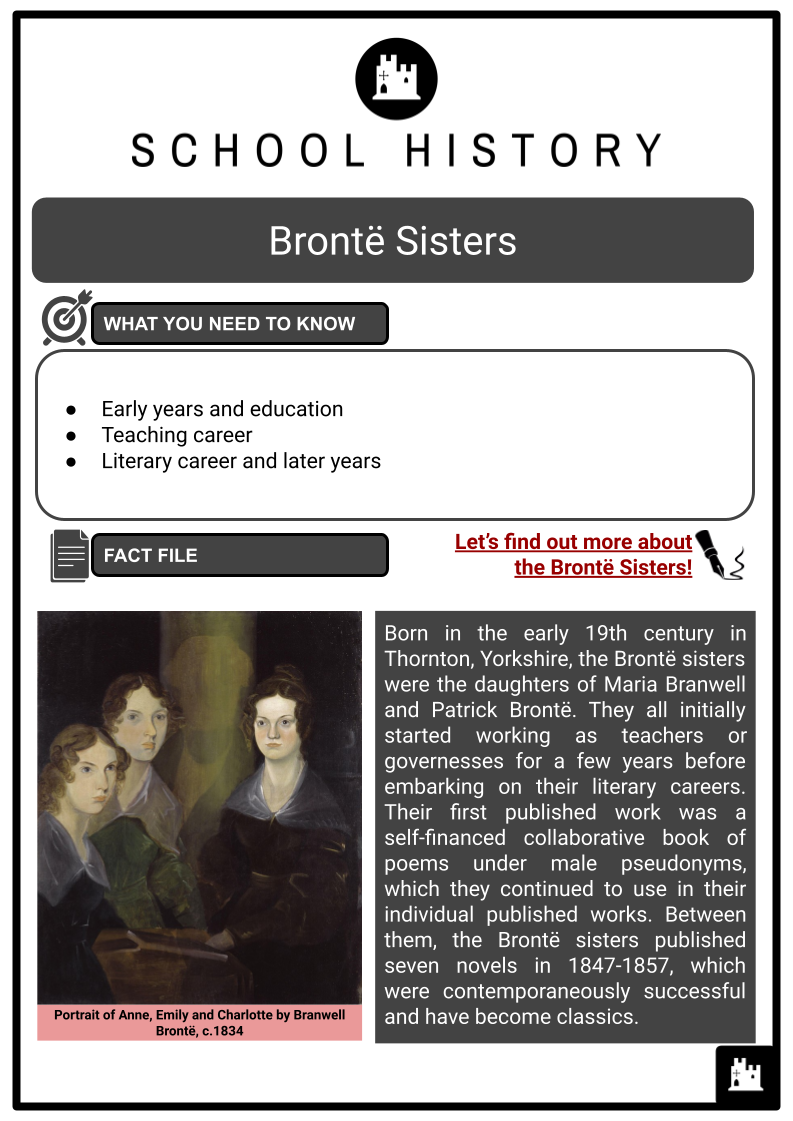
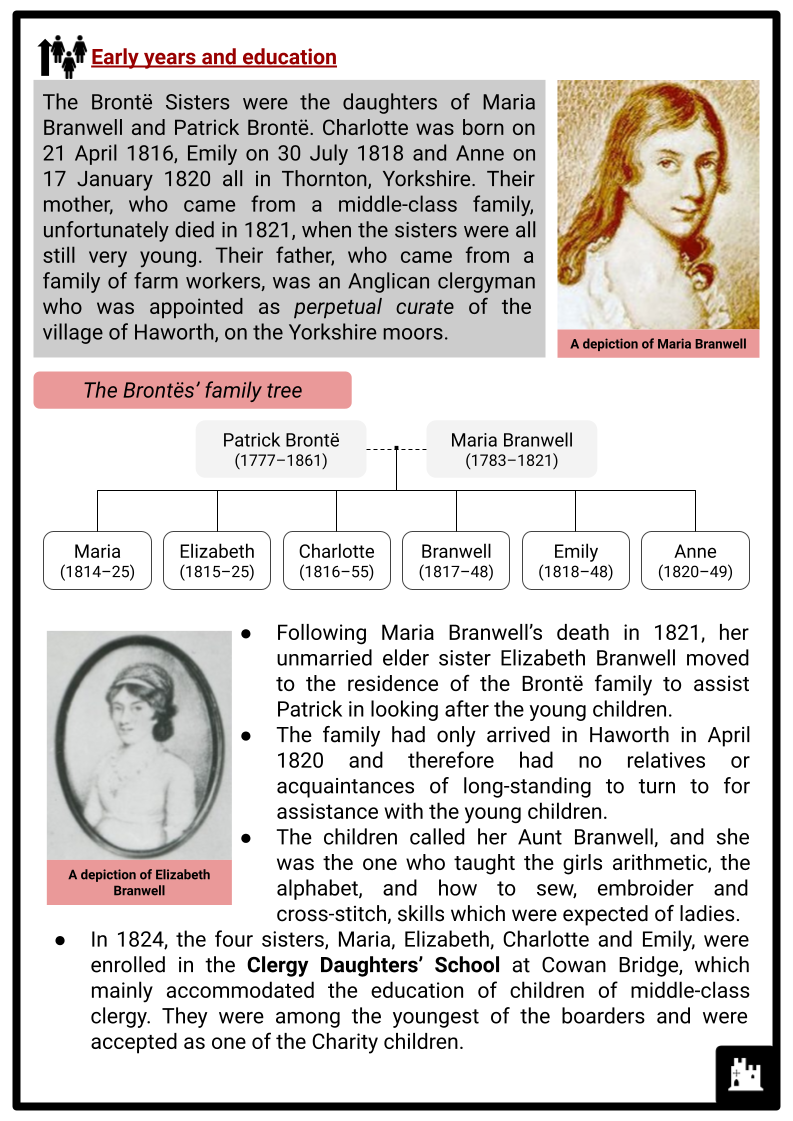
Student Activities
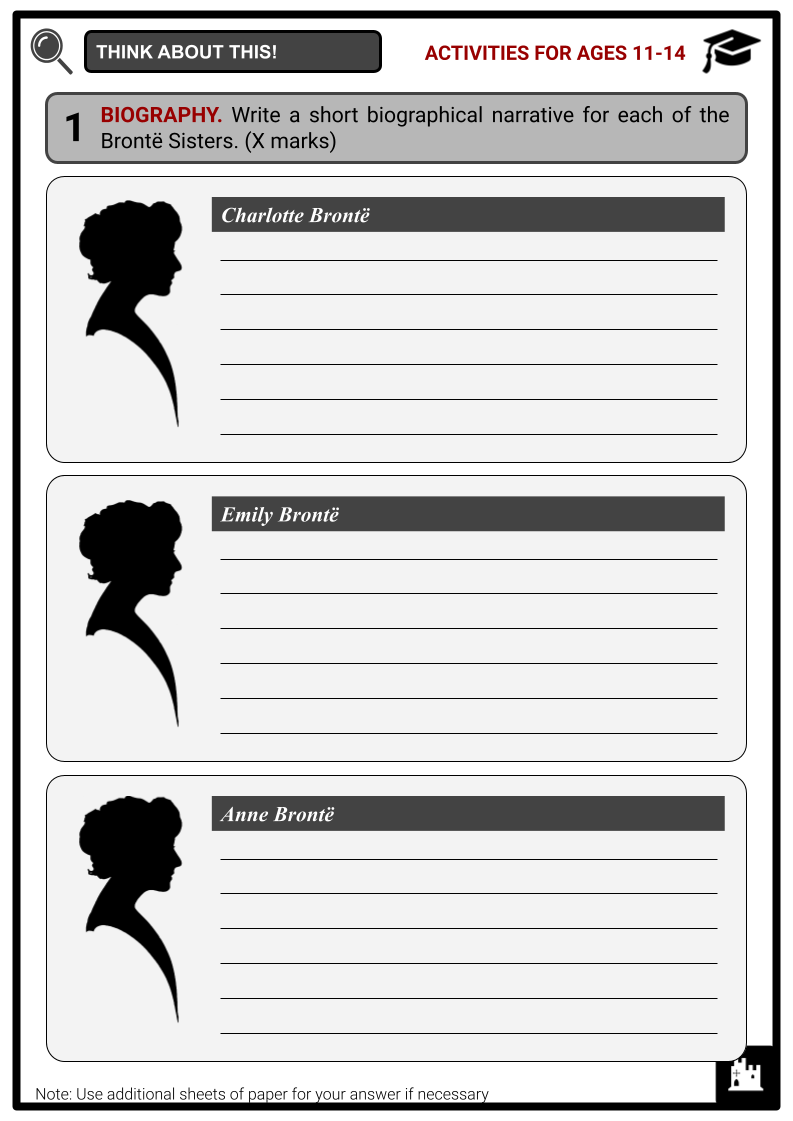
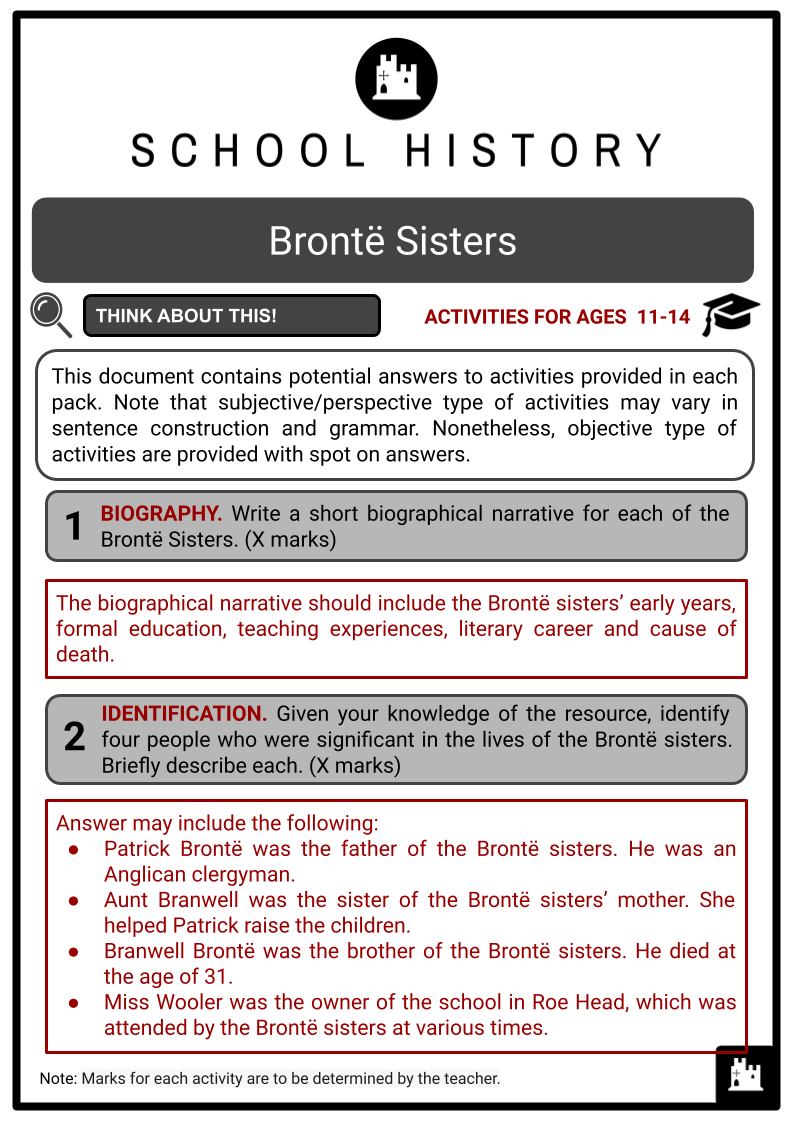
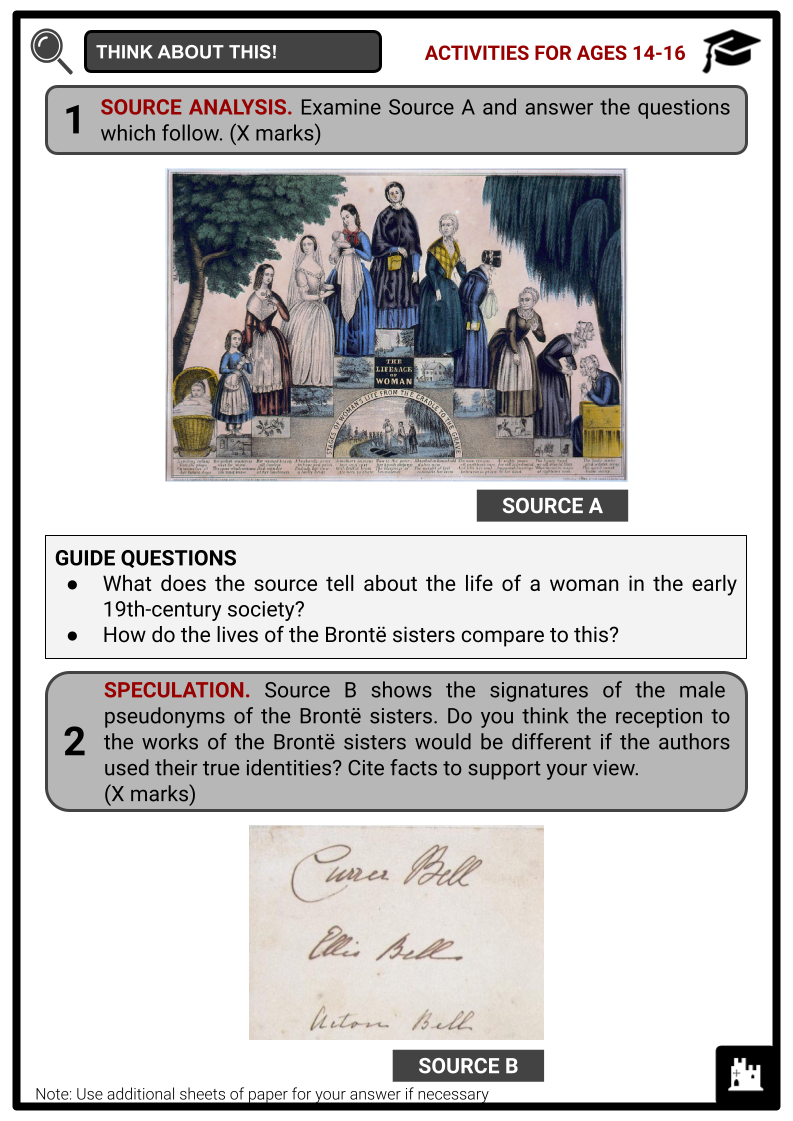
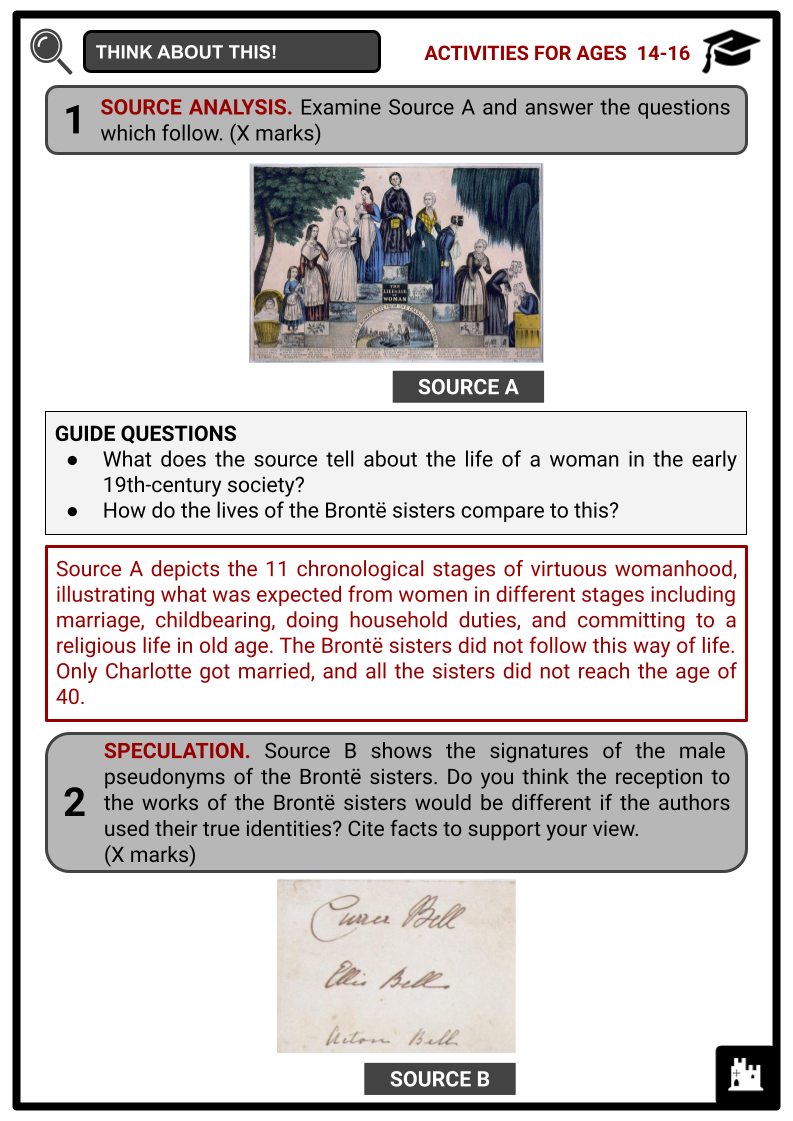
Summary
- Early years and education
- Teaching career
- Literary career and later years
Key Facts And Information
Let’s find out more about the Brontë Sisters!
Born in the early 19th century in Thornton, Yorkshire, the Brontë sisters were the daughters of Maria Branwell and Patrick Brontë. They all initially started working as teachers or governesses for a few years before embarking on their literary careers. Their first published work was a self-financed collaborative book of poems under male pseudonyms, which they continued to use in their individual published works. Between them, the Brontë sisters published seven novels in 1847-1857, which were contemporaneously successful and have become classics.
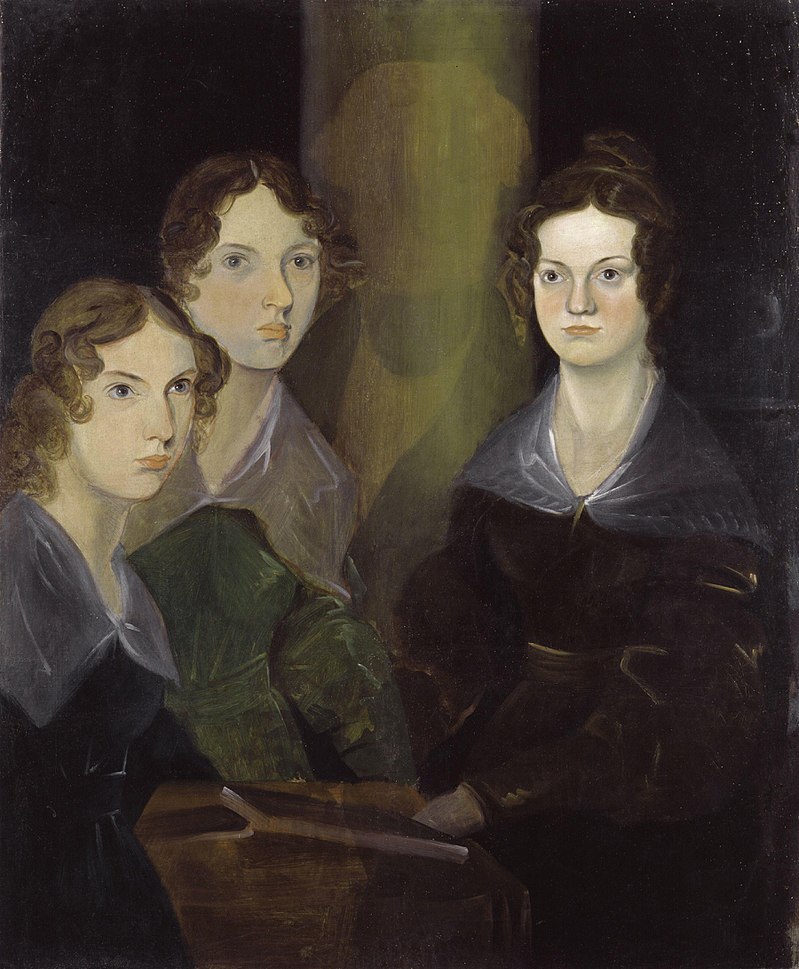
Early years and education
- The Brontë Sisters were the daughters of Maria Branwell and Patrick Brontë. Charlotte was born on 21 April 1816, Emily on 30 July 1818 and Anne on 17 January 1820 all in Thornton, Yorkshire. Their mother, who came from a middle-class family, unfortunately died in 1821, when the sisters were all still very young. Their father, who came from a family of farm workers, was an Anglican clergyman who was appointed as perpetual curate of the village of Haworth, on the Yorkshire moors.
- Following Maria Branwell’s death in 1821, her unmarried elder sister Elizabeth Branwell moved to the residence of the Brontë family to assist Patrick in looking after the young children.
- The family had only arrived in Haworth in April 1820 and therefore had no relatives or acquaintances of long-standing to turn to for assistance with the young children.

- The children called her Aunt Branwell, and she was the one who taught the girls arithmetic, the alphabet, and how to sew, embroider and cross-stitch, skills which were expected of ladies.
- In 1824, the four sisters, Maria, Elizabeth, Charlotte and Emily, were enrolled in the Clergy Daughters’ School at Cowan Bridge, which mainly accommodated the education of children of middle-class clergy. They were among the youngest of the boarders and were accepted as one of the Charity children.
- History, geography, grammar, writing, arithmetic, needlework and “the nicer kinds of household work” were to be taught at the Clergy Daughters’ School. French, drawing and music were also part of the syllabus as extras.
- In 1825, the two eldest girls developed an advanced case of tuberculosis in the aftermath of a typhoid outbreak and were consequently withdrawn from the school.
- Upon seeing the state of his two daughters, Patrick immediately removed Charlotte and Emily from the school and brought them back to Haworth.
- Maria and Elizabeth did not survive and died in May and June of that year, respectively. The death of the two eldest sisters impacted the surviving sisters, especially Charlotte.
- The Brontë sisters and their brother Branwell were then educated at home by their father and Aunt Branwell.
- In 1829–30, an artist of some local repute from nearby Keighley, John Bradley, was employed as drawing master for the Brontë children. Meanwhile, the Keighley church organist gave piano lessons to them.
- In 1831, Charlotte, aged 14, entered the school ran by Miss Wooler and her sisters in Roe Head, Mirfield.
- The school had only opened in 1830, with fees that the Brontë family could barely afford. Despite this, their father chose to enrol Charlotte there given the school’s good reputation.
- She enjoyed her studies and found many lifelong friends in Roe Head. In 1832, she returned home and was happy to be with her family again.
- In 1835, she was offered a position as the assistant of Miss Wooler. She accepted it and brought Emily with her as a pupil. Her salary partly covered Emily’s fees.
- It was the first time Emily, now aged 17, left Haworth since leaving Cowan Bridge. Emily had trouble settling into school life and suffered from extreme homesickness. As a result, she left school after only a few months.
- Emily returned to the Haworth Parsonage, and Anne, aged 15, took her place in Roe Head. It was also Anne’s first time to be away from Haworth, but she was determined to stay in school in order to obtain the education she would need to support herself.
- She made few friends and made great progress in school. In fact, she won a good-conduct medal in December 1836.
- She stayed in the school for two years, only returning home during Christmas and summer holidays.
- In December 1837, Anne fell ill with gastritis and was greatly disturbed by the Calvinistic doctrines that she encountered in the school. Charlotte wrote to their father, and he brought Anne home. In 1838, the Roe Head school was relocated. Charlotte, who had been unhappy and lonely as a teacher in the school, resigned. Her health was also suffering at the time.
Teaching career
- Having obtained sufficient education, Emily and Anne also began their careers as teachers or governesses. Such careers were among the few options for less privileged and educated women. The three sisters would later find such careers challenging.
- Dissatisfied with the children’s progress, the Inghams dismissed Anne, who then returned home in Christmas 1839.
- At that time, Emily was also at home and had taken the responsibility of maintaining the household at Haworth since she left Law Hill School in April. Charlotte, who had recently left her job, and Branwell were also in the Parsonage.
- The family’s finances did not improve, and Aunt Branwell had to manage it carefully.
- Whilst Emily had to remain home for her health, Charlotte and Anne sought work again. Emily learned German from books and practised piano, which she played with natural brilliance.
- In 1840, Anne was accepted as governess of the Robinson children at Thorp Green Hall near York. Although she did not like her situation, she was determined to maintain her job and soon became well-liked by her employers. She stayed with the Robinsons and only went home during holidays at Christmas and in June.
- Meanwhile, Charlotte became a governess for the White family at Upperwood House, Rawdon. She taught the children between February and December 1841.
- Believing that she and her sisters were intellectually capable of setting up a school for young girls, Charlotte decided to train abroad with the intention of teaching modern languages to children later on.
- Belgium was chosen as the place where the sisters could train, and the funds for this endeavour were provided by Aunt Branwell.
- In early 1842, Charlotte and Emily, accompanied by their father, arrived in Brussels and enrolled at a boarding school which was owned by Claire and Constantin Héger.
- They hoped to perfect their French and German before opening their school, and therefore remained committed to their studies.
- Constantin was responsible for the higher French classes.
- By the end of the term, Charlotte and Emily were so competent in French that Madame Héger suggested that they both stay for another six months free of charge in exchange for giving lessons.
- Charlotte was offered to teach English and Emily to teach music. They accepted these after much hesitation.
- In October 1842, Aunt Branwell died, forcing the two, as well as Anne, to return to Haworth. She left all her worldly goods in equal shares to her nieces and a cousin in Penzance. This inheritance enabled the family to pay off their debts and provide them with a small reserve of funds.
- In January 1843, Charlotte returned alone to Belgium and Anne to Thorp Green. The latter also secured a position for Branwell. In 1844, the sisters’ plan to open a school in their house was held back because they were unable to attract students due to the school’s location. By 1845, the family were back together at Haworth.
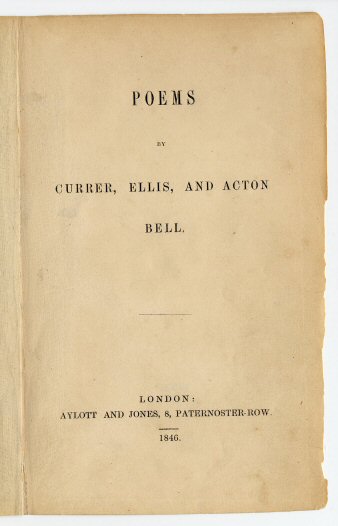
Literary career and later years
- The surviving Brontë children saw writing, initially as a game and then as a hobby, from a young age. Their creativity and imagination were sparked by the twelve wooden soldiers that their father gave to Branwell in 1826. They soon started making stories with accompanying illustrations, creating the imaginary African kingdom of Glass Town and the Empire of Angria. When Charlotte left for school, Emily and Anne created the imaginary world of Gondal. The complexities of the stories they wrote matured, influenced by various media such as periodicals, newspapers and prints of engravings, as well as their working and life experiences. While they initially pursued a different career, their interest in writing never disappeared.
- Although Charlotte received demotivating advice about pursuing a career in writing, she did not allow herself to be discouraged.
- She envisioned a collaborative book of poems with her sisters. After convincing her two sisters to share the work with her, the three chose the poems to be included and went about searching for a publisher.
- In 1846, their self-financed work was published using the male pseudonyms of Currer (Charlotte), Ellis (Emily) and Acton (Anne) Bell.
- The three sisters’ first published book attracted little attention, with only three copies sold.
- They started writing novels and incessantly discussed their work without the knowledge of their father. Each sister would have a book in print before 1847 ended. Charlotte published four novels, Emily one and Anne two.
The Brontë Sisters books in publication order (1847–1857)
Jane Eyre - Charlotte Brontë - October 1847
- It is a first-person narrative novel. It is a bildungsroman, a coming-of-age story.
- It was published under her pen name by Smith, Elder & Co. of London.
- It was extremely successful, with contemporaneous reviews generally critical.
Wuthering Heights - Emily Brontë - December 1847
- It is the only novel by Emily.
- It was published under her pen name by Thomas Newby.
- The novel was influenced by Romanticism and Gothic fiction and received polarised contemporaneous reviews.
Agnes Grey - Anne Brontë - December 1847
- It is a novel that is thought to be based on the experiences of Anne as a governess for five years.
- It takes some stylistic approaches of a bildungsroman.
- It was published under her pen name by Thomas Newby.
The Tenant of Wildfell Hall - Anne Brontë - June 1848
- It is Anne’s second novel published under her pen name.
- It had an instant and phenomenal success and is considered to be one of the first feminist novels.
Shirley - Charlotte Brontë - 1849
- It is a novel set against the backdrop of the Luddite uprisings in the Yorkshire textile industry.
- It received a muted reception from critics.
- Owing to its popularity, ‘Shirley’ became a name for women.
Villette - Charlotte Brontë - 1853
- It is a first-person narrative novel published under Charlotte’s pen name.
- It was based on her own experiences in Brussels.
- It was the third and last novel published during her life.
The Professor - Charlotte Brontë - 1857
- It was Charlotte’s first novel submitted for publication in 1847 but was rejected by many publishing houses.
- It was published posthumously, with the approval of her widower.
- It was written from a first-person perspective of a young Englishman.
- In July 1848, Charlotte and Anne travelled to London by train to visit the office of their publisher, Smith, Elder & Co., with the intention to prove that each sister was indeed an independent author, rather than just one man as the spreading rumour claimed.
- Since that time, the true identity of the ‘Bell brothers’ had been known to a select few, including the Brontë sisters’ father.
- In September of that year, Branwell, who had developed an addiction to alcohol and drugs by then, died at the age of 31 at Haworth Parsonage. He was the first of the Brontës to be a published poet, with several of his poems published in local newspapers under the name of Northangerland in the 1840s.
- It is believed that he never knew that his sisters had a word published.
- At Branwell’s funeral service, Emily caught a severe cold that quickly led to tuberculosis. She initially refused medical aid but when she became willing to see a doctor, it was too late. She died on 19 December 1848.
- This seriously affected and undermined the physical health of Anne, who, along with the whole family, had suffered from coughs and colds during the winter of 1848.
- Anne had influenza, and so, she took all the recommended medicines and advice from the physician.
- On 24 May 1849, Anne, who remained ill, set off for Scarborough with Charlotte and Ellen Nussey, hoping that the fresh sea air would be good for her.
- On 28 May, Anne, aged 29, died of pulmonary tuberculosis in Scarborough. She was buried there a few days later.
- Charlotte resumed writing as a way of dealing with her grief after Anne’s death.
- Persuaded by her publisher to make occasional visits to London, Charlotte started to move in literary circles and revealed her true identity.
- In 1851, she visited the Great Exhibition in London and attended a series of lectures given by William Makepeace Thackeray, an English novelist with whom she became friends.
- In 1852, she received a marriage proposal from Irishman Arthur Bell Nicholls, who had been curate of Haworth for seven and a half years. This was objected to by her father and declined by Charlotte. Nicholls left Haworth in the following year.
- By January 1854, Charlotte had accepted the marriage proposal, which was then received the approval of her father.
- Charlotte and Nicholls married in June and went to Banagher, County Offaly, Ireland, for their honeymoon.
- Charlotte soon fell pregnant after the wedding. However, her health quickly declined. On 31 March 1855, a few weeks before her birthday, she died with her unborn child. She was buried in the family vault in the Church of St Michael and All Angels at Haworth. In 1857, the same year that The Professor was published, the Life of Charlotte Brontë, authored by her friend Elizabeth Gaskell was published.
Frequently Asked Questions
- Who were the Brontë Sisters?
The Brontë Sisters were a trio of 19th-century British authors: Charlotte, Emily, and Anne Brontë. They are renowned for their contributions to English literature.
- What are the most famous works by the Brontë Sisters?
Charlotte Brontë is best known for "Jane Eyre," Emily Brontë for "Wuthering Heights," and Anne Brontë for "The Tenant of Wildfell Hall."
- What genre did the Brontë Sisters write in?
The Brontë Sisters wrote primarily in the genre of Gothic fiction, characterised by elements of mystery, darkness, and romance. However, their works also explore themes such as social class, morality, and the role of women in society.
